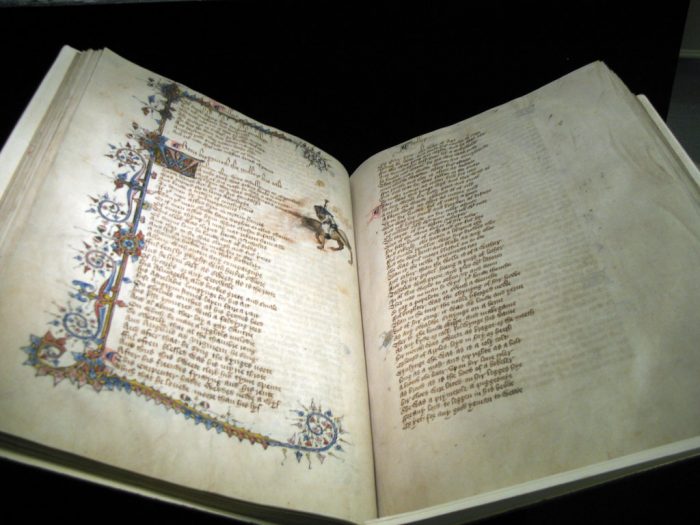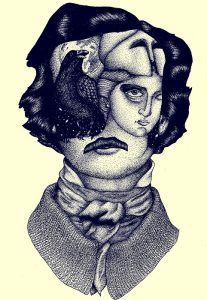Medieval (about 476AD-1600’s)
20
Justin Wakely
introduction
The outbreak of the Bubonic Plague is known for shattering European societies, however there were also two other types of this plague that existed. It was due to these plagues that major works of literature were produced. Likewise, the outbreak of these plagues forced humans to establish new technology and cultural ideas to transform what was, at the time, the most life threatening disease in existence into an uncommon disease of the past.
Science Behind the Plague
There are three classifications of the plague and they are all contagious through the eyes, mouth, nose, openings, wounds, or bites.

Obviously, there is the Bubonic Plague which, as mentioned previously, caused intense flu-like symptoms. However, the two that have not been talked about are the Septicemic Plague and Pneumonic Plague. Septicemic Plague causes an infection of the blood and the Pneumonic Plague caused a severe lung infection. While all three types of the plague have different characteristics, they are all caused by the Yersinia pestis bacterium which was discovered at the end of the nineteenth century by Alexandre Yersin (Centers for Disease Control, 2019). While there are three forms of the plague with distinct defining characteristics, it was very common to have multiple forms of the plague all at one time.
In recent decades, the bubonic plagues’ threat has been greatly reduced. An average of seven human plague cases have been reported each year in the United States from 2000 to 2017. However, there are still places where the plague has a stronger impact. For example, Madagascar currently leads in the amount of reported plague cases by country from 2010 to 2015. They had over one thousand reported plague cases within the five years (Centers for Disease Control, 2019).“Today, modern antibiotics are effective in treating plague. Without prompt treatment, the disease can cause serious illness or death.” – Centers for Disease Control and Prevention, 2019
In the modern world, people with the plague need to be treated right away. If treatment is not received within 24 hours of the first symptoms, the risk of death increases. Oppositely, in medieval times the disease was extremely efficient and could leave a completely healthy man to wake up dead in the morning. According to the Centers for Disease Control and Prevention, “Today, modern antibiotics are effective in treating plague. Without prompt treatment, the disease can cause serious illness or death,” (Centers for Disease Control, 2019). These modern antibiotics are those such as streptomycin, gentamicin, doxycycline, and ciprofloxacin. Likewise, oxygen, fluids, and respiratory support are usually also needed. Lastly, people with the plague must be kept away from caregivers and other patients (Centers for Disease Control, 2012). This note is important because it shows how the idea of quarantine is still actively practiced in the modern world.
Literature Produced by the the Plague

Healthy people did all they could to avoid the sick. Many people even fled cities for the countryside, but they could not successfully escape the disease because of infected people and animals along the way. Furthermore, so many sheep died that one of the consequences of the Black Death was a European wool shortage.
Giovanni Boccaccio’s firsthand accounts during the Bubonic Plague’s rampant takeover of Europe portray the vast destruction to society that it caused. He states that the plague caused people to act selfishly or act out of self-interest. Likewise, he describes that the idea of survival was based on the idea of “every man for himself.”’ On a contrary note, also Boccaccio believes that the Bubonic Plague forced Europe into accepting more Utilitarian ideas because society as a whole realized that they needed to work together in order to prevent major problems such as the spread of disease (Boccaccio, 2003). This is one of the many sources of moral duality that defines life during the plague.

Other famous works of literature were also produced during this time, like the Canterbury Tales by Geoffrey Chaucer. An important narrative within this story is the Pardoner’s Tale. (Chaucer, 2007) The overall moral of the Pardoner’s Tale is that sin and treachery will lead to death. While this seems like a typical theme for a story, this moral was especially important in the time it was written. At the time this story was released people thought the death from the Plague was due to
sin. One medieval doctor even believed that you merely had to look at someone that was infected in order for you to become infected. He believed that the sickness was a sin-guided spirit that was going from body to body.

Another famous part of this tale that directly relates to the Bubonic Plague is that the main characters find a dead man’s gold under a tree but will not dare to touch it. It can be assumed that this man died of the plague and also that the main characters do not want to touch the gold due to the threat of infection.
An additional literary work of art that is based on the premise of the Bubonic Plague is the Masque of the Red Death by Edgar Allan Poe. A Forbes article states, “The [Bubonic Plague] inspired Edgar Allan Poe to write perhaps the most chilling of his short horror stories, The Masque of the Red Death,” (Taylor 2011). This is especially evident when analyzing the contents of the story. This story is about a fictional disease called the red death that is gruesome and fatal. Furthermore, the disease has wiped out half of the kingdom that the story takes place in. This story’s themes derive directly from the Bubonic Plague and the gruesomeness that is present directly reflects the gruesomeness that was present during the plague’s presence.
Conclusion
The Bubonic Plague is the most well known version of the plague, but the Septicemic and Pneumonic Plagues were also running rampant simultaneously. It was because of these three plagues that major works of literature were produced, and these plagues allowed for the creation of new themes and ideas within literature and, more importantly, in everyday life.
Chapter Questions
- Multiple Choice: Which is NOT one of the three classifications of the Plague?
a) Bubonic
b) Pneumonic
c) Glycemic
d) Septicemic - True or False: The Bubonic Plague no longer exists today.
- Short Response: What are the major literary themes that were able to be produced due to to the presence of the plague? Furthermore, explain the specific ways in which the plague influenced these themes.
References
Boccaccio, G. (2003). The Decameron, Volume I by Giovanni Boccaccio, translated and with an introduction by J.M. Rigg. Retrieved from http://www.gutenberg.org/ebooks/3726.
Centers for Disease Control (2012) History of Quarantine. CDC: Quarantine and Isolation. Retrieved from https://www.cdc.gov/quarantine/historyquarantine.html
Centers for Disease Control. (2019). Plague. CDC: Plague. Retrieved from https://www.cdc.gov/plague/index.html.
Chaucer, Geoffrey. (2007) The Canterbury Tales. The Project Gutenberg EBook of Chaucer’s Works, Volume 4 (of 7). http://www.gutenberg.org/files/22120/22120-h/22120-h.htm
Mullett, Charles F. (1956) The bubonic plague and England: an essay in the history of preventive medicine. University of Kentucky Press.
Taylor, James. (2011). The Black Death: Longing for the Good Old Days. Forbes. (2011, June 15). Retrieved from https://www.forbes.com/sites/jamestaylor/2011/06/15/the-black-death-longing-for-the-good-old-days/#5bc226207440
History.com Editors. (2010, September 17). Black Death. History.com. Retrieved from https://www.history.com/topics/middle-ages/black-death.
images
“canterbury-tales” by rezendi is licensed under CC BY 2.0
“Edgar Allan Poe – The Raven / Illustration” by Verdran Stimac is licensed under CC BY-NC-ND 4.0
“Portrait of Giovanni Boccaccio” by Raffaelle Morghen is in the Public Domain
“Yersinia pestis Bacteria” by NIAID is licensed under CC BY 2.0
